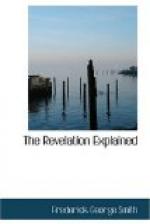But the real occasion of the revolt of the northern nations of Europe against the jurisdiction of Rome was the controversy regarding indulgences. “These in the Catholic church, are remissions, to penitents of punishment due for sin, upon the performances of some work of mercy or piety, or the payment of a sum of money.” When Leo X. was elected to the Papal dignity (1513), he found the church in great need of money for the building of Saint Peter’s and other undertakings, and he had recourse to a grant of indulgences to fill the coffers of the church. The power of dispensing these indulgences in Saxony in Germany was given to a Dominican friar named Tetzel. This fanatic enthusiast entertained the most exaggerated opinion of the efficacy of indulgences. In his harrangues he uttered such expressions as the following:
“Indulgences are the most precious and the most noble of God’s gifts.” “There is no sin so great that an indulgence can not remit; ... only let him pay well, and all will be forgiven him.” “Come, and I will give you letters, all properly sealed, by which even the sins that you intend to commit may be pardoned.” “I would not change my privileges for those of St. Peter in heaven; for I have saved more souls by my indulgences than the apostle by his sermons.” “The Lord Omnipotent hath ceased to reign; he has resigned all power to the Pope.” See D’Aubigne’s History of the Reformation, Book III, Chap. 1.
Martin Luther was an Augustine monk and a teacher of theology in the University of Wittemberg. Before Tetzel appeared in Germany, Luther possessed a wide reputation for learning and piety, and he had also entertained doubts respecting many of the doctrines of the church. During an official visit to Rome in 1510 he was almost overwhelmed with sorrow because of the moral corruption there; but while penitentially ascending on his knees the sacred stairs of the Lateran, he seemed to hear a voice thundering in his soul, “The just shall live by faith!” This marked an important epoch in his career.
When Tetzel appeared in Saxony with his indulgences, Luther fearlessly opposed him. He drew up ninety-five theses against the infamous traffic and nailed them to the door of the church at Wittemberg, and invited all scholars to criticise them and point out if they were opposed to the doctrine of the Word of God or of the early church Fathers. Here the invention of printing proved to be a powerful agency in advancing the cause of reformation by scattering copies of these theses everywhere; and soon the continent of Europe was in a perfect turmoil of controversy. The Pope excommunicated Luther as a heretic. In reply Luther burned the Papal bull publicly at Wittemberg. Shortly afterward Luther produced his celebrated translation of the Bible in the German language. Even a brief history of the entire Reformation would be too large for the limits of the present volume, therefore with a few words respecting the nature of the work of the Reformation we will pass on to another prophetic vision.




